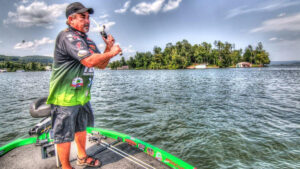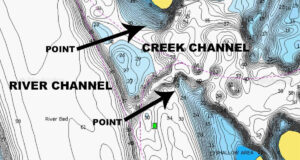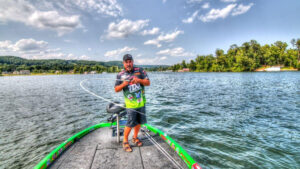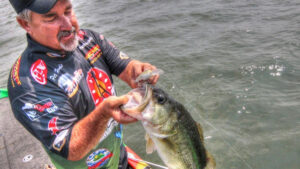“Yeah, I caught ‘em off deep river channel ledges this past week.”
“I’ve been on a good shallow bite in the mornings.”
Let’s think about something—when’s the last time you’ve heard someone utter the words “mid-depth” when talking about bass fishing? It almost seems like that’s not a hip thing to say these days. Your fishing buddies will look at you like you’re the biggest geek on the planet. It’s like blaring Nickelback as you cruise down the sidewalk on your new electric-powered scooter. You just don’t do it, man.
The ugly truth is, the large majority of bass anglers believe bass live either in shallow or deep water. There’s no grey area and many of us refuse to think otherwise. Throughout the summer, however, the mid-depth zone—we’ll call it 7 to 12 feet of water—can be absolutely loaded with big bass. And guess what? Very few people pay any attention to it.
Professional angler Pete Ponds has enjoyed excellent summer bass fishing success while targeting this oft-ignored depth range with crankbaits. When the water temperature reaches the 80 to 90-degree mark, he’ll have the most productive water all to himself.
Before you get out there and start winging your favorite crankbait around, there are several components worth considering.
Ignore the misconceptions
Many of us assume that summer bass live in deep water. We’re always told how the water’s more comfortable, they’re recooperating from the spring spawning period and they’re relating to deep schools of bait. We accept it as fact and never really question it.
Ponds, however, has a totally different thought process. While he does believe a certain percentage of the bass population spends the summer months in deep water, he’s careful to avoid tunnel vision.
“The 7 to 12-foot range holds a tremendous number of bass,” Ponds said. “Sure, some bass live deep and some even live shallow all year long. But they get pounded by fishing pressure because they’re easier to access. I honestly believe that the mid-depth range plays host to more resident fish than any other. Not to mention, it’s not very difficult to make these fish bite.”
Vegetation growth also plays a big role in his theory. In many lakes, submergent grass stops growing in the 8-foot depth range due to a reduction in light penetration. When this vegetation stops and transitions into a smoother bottom composition, an edge is created. Bass will use these edges not only for traveling, but also for camouflage as they ambush unsuspecting prey.
Use the thermocline to your advantage
It’s not uncommon to hear anglers curse the thermocline. While it does make summer bass fishing a bit more challenging at times, a little understanding can go a long way.
The thermocline is essentially a temperature-related level at which the lake stratifies. Below the thermocline, the ecosystem has consumed all of the available oxygen—this is when you’ll start seeing catfish, drum and small mussels floating to the surface. They’re simply out of oxygen. Because the water above the thermocline supports life much better due to higher oxygen levels, both the bass and the baitfish have no other choice than to sit above it.
“When you’re looking at your depth finder and notice most of the shad inhabiting a certain depth, it’s a safe bet that you’ve found the thermocline,” Ponds said. “It will be within a few feet of that depth range. It’s the most comfortable place for a summer bass—the deep water has very little oxygen and the shallow water is far too warm for their liking. I can actually increase the sensitivity of my Humminbird ONIX and see the thermocline as a solid, horizontal line.”
As the thermocline pushes bass towards the “magic” mid-depth range we’re discussing, Ponds simply looks for any type of structure or cover that intersects with that particular depth. Whether it’s a shallow ditch, a hump or even a manmade brush pile, there’s a great chance you’ll find bass in these areas.
Primary factors to consider
Although this mid-depth cranking is a highly effective technique, don’t assume you can aimlessly troll around in 7 to 12 feet of water and catch ‘em all day—unfortunately, it’s not that easy. Ponds pays close attention to several critical factors in order to zero-in on a productive pattern.
- Water clarity— “In clear lakes, you’ll start losing some light penetration in the 10 to 12-foot zone,” Ponds said. “The lack of light makes bass feel more secure, so you’re likely to catch them a little deeper in these situations. In dirty water, however, I’ve found that most of the bass hang out in the top-end of that mid-depth spectrum in 7 to 8 feet of water.”
- Current— Similar to deep offshore structure fishing, current can have a big influence on your mid-depth cranking success as well. Whether it’s power-generation current, wind current or natural current, the bass will hold on the backside of current breaks in order to ambush and feed on passing prey. Basically, Ponds looks for anything that protrudes into the current and creates an eddy and makes multiple casts to the area.
- Vegetation irregularities— “Fishing these deeper grass lines is almost exactly like frogging and pitching a jig to shallow grass,” Ponds said. “You’re looking for something different—any irregularities such as points, indentations or a slight depth change. You’ll have much more success dissecting these small areas as opposed to cranking down a giant, straight grass line.”
- Creek and river intersections— Throughout the country, Ponds enjoys continuous mid-depth cranking success by targeting areas where a smaller creek dumps into the main river of a fishery. This creates two points—one on either side of the intersection—that serve as high percentage spots. He’ll fish on top of these points, as they offer bass four important things: Comfortable water, abundant feeding opportunities, current and easy access to deep water.
Bottom contact is not a necessity
Most anglers like to dig the bottom with their crankbaits; something about feeling that plug thump across cover just feels “right”. While it might put you outside of your comfort zone, Ponds actually suggests the opposite.
“I’m not a big believer in bottom contact when I’m cranking in the mid-depth zone,” Ponds said. “The bass are often suspended this time of year and I like to keep my crankbait above them so they can feed upwards—it’s hard to make a bass swim down to eat your lure. So if I’m seeing bass suspended in 14 feet of water, I’ll throw my Bandit 250 Ledge Series on heavier 14-pound Vicious Pro Elite Fluorocarbon to keep that bait above them.”
Moral of the story? Most of us don’t like to target suspended bass. We live to find ‘em lined up across the bottom when we’re fishing away from the bank. But don’t let that ruffle your feathers when you’re trying this technique. Surprisingly, Ponds actually prefers to target suspended bass when he’s mid-depth cranking.
Avoid the “robot mode”
Crankbait fishing seems simple enough, right? Make a long cast, put your rod tip down and start winding. And winding. And winding. Once you go a while without a bite, you’re not even really paying attention. You’re looking at houses, playing with your electronics, checking out the clouds—you’re in what we call “robot mode”.
Refrain from this at all costs. You might catch a few fish with a steady retrieve, but Ponds relies on a much more involved technique this time of year.
“Because most of these bass will be suspended in the mid-summer, I’ve found a sweeping retrieve to be incredibly effective,” Ponds said. “It works extremely well. Basically, you’re making long, sideways sweeps of your rod in order to move the crankbait. You’re only using the reel to eat up your slack line. 90 percent of your bites will happen on the pause and they’ll usually feel like an aggressive jig bite. I use a 7-foot, 1-inch medium-action Duckett White Ice Casting Rod and it gives me the sensitivity to feel these bites on the pause while also maintaining enough backbone for a solid hookset.”
Where there’s one, there’s more
Ponds refers to mid-depth summer cranking as a “double-edged” sword. It’s very possible that you can go hours without a bite, but when you finally run across one, its slimy, green buddies are never far away.
“This is an excellent time of year to catch numbers, but you’ll probably have to endure some pretty slow fishing in-between the action,” Ponds said. “When you catch one, it’s almost a guarantee that you’ll catch four or five more. Heck, I’ve caught 30 bass in 30 casts before while using this technique. Summer bass congregate in particular areas for a reason. It’s never a fluke this time of year.”
Ponds relies on natural colors such as Natural Shad and Fried Squash in clear water, while turning to brighter colors such as Chartreuse Blue in dirty water.
In order to maximize your catch on an active school of bass, it’s imperative to pay close attention to your casting angles. According to Ponds, most of the areas you’ll find are roughly the size of a car hood, making it difficult to hit “the juice” on each and every cast.
“When I hook my first bass in an area, I immediately line my boat up with something on the bank for a visible reference,” Ponds said. “I need to know exactly where the fish came from so I can duplicate my cast. Not many people talk about triangulation these days, but it’s a technique that is hugely important when you’re doing this. If you’re not comfortable with triangulation, simply keep a marker buoy on your front deck. When you get bit, kick it overboard so at least you’ll knot where your boat was sitting when you got the bite.”
Cycle through your baits and areas
You’ll hear a lot of pros talk about “firing up” a school of bass, and for good reason—it’s a really big deal throughout the summer. If you’ve ever played with a cat, you already understand what they’re talking about. You’ll dangle the toy in front of the cat, it’ll do a bunch of weird cat things with it for a few minutes and then it’s over. The cat has lost interest and has nothing to do with you anymore.
Bass are the same way.
“There are some rare instances in which you can catch a bass on every cast for 20 minutes while using the same crankbait,” Ponds said. “But that’s rare. After several catches, the fish can become conditioned to the sound, action and color and quit biting altogether. That’s why it’s important to have some sort of clean-up bait available. My personal favorite is the 5/8-ounce Talon Baits Preacher Jig. It’s more subtle than a crankbait and it’s solely a bottom-contact presentation. It just gives them a totally different look and there’s a great chance you can reignite that school by putting the crankbait down.”
Just as he’ll cycle through a few different baits and colors, Ponds also makes an effort to let an area rest after he’s beat it up. Like he mentioned earlier, the bass are in that area for a reason and it will most likely replenish. So he’ll fish some nearby areas for about 45 minutes, come back and recommence the whack-fest.
Pay attention before unhooking
Okay, so you’ve caught several fish on a mid-depth crankbait in a very specific area. But you’re a bass fisherman—you want to catch more. “Several” is never enough for us. By simply paying attention before you unhook your bass, you can learn a lot about what’s really going on.
“You’ll know when you’re throwing the right color,” Ponds said. “Because they’ll absolutely inhale your crankbait. If the fish is hooked on the outside of the head, in the outside corner of the mouth or barely skin-hooked by the back treble, you need to make a color change. I can’t stress that enough because tiny little changes can make the difference between catching three or 25 out of an area.”
Don’t fall into the “shallow” and “deep” crowd this summer. Yes, that stuff all has its time and place, but mid-depth cranking gives you an opportunity to catch fish that very few, if any, other anglers have found. If you can dedicate some time to this technique and heed Ponds’ advice, you’ll have one heck of a remedy for summertime bass fishing.
















